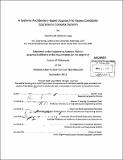| dc.contributor.advisor | Warren P. Seering, Olivier de Weck, Sheila Widnall and Eric Rebentisch. | en_US |
| dc.contributor.author | Long, David Scott Andrew | en_US |
| dc.contributor.other | Massachusetts Institute of Technology. Engineering Systems Division. | en_US |
| dc.date.accessioned | 2013-07-10T14:49:51Z | |
| dc.date.available | 2013-07-10T14:49:51Z | |
| dc.date.issued | 2012 | en_US |
| dc.identifier.uri | http://hdl.handle.net/1721.1/79501 | |
| dc.description | Thesis (Ph. D.)--Massachusetts Institute of Technology, Engineering Systems Division, 2012. | en_US |
| dc.description | "September 2012." Cataloged from PDF version of thesis. | en_US |
| dc.description | Includes bibliographical references (p. 163-167). | en_US |
| dc.description.abstract | The Compatibility Assessment Method (CAM), a new structured process for assessing compatibility between parent systems and child subsystems is proposed and applied to several cases where subsystems are being replaced in legacy systems. CAM is a screening process intended to be used by project managers who need to replace components of complex systems. The functional model-based process uses an extension of the Integrated Definition Modeling Language of IDEFO. The IDEFO method is used for defining compatibility measures based on each of the four constituent arrows that show inputs, controls, outputs, and mechanisms (ICOM). In this extension, the control constituents are replaced with constraints. Each of the ICOM constituents is expanded with parameters which include metrics and values. The ICOMs with their parameters and metrics are then used to characterize two or more subsystems in a matrix format. The differences between these matrices are entered into the sparse "Delta Matrix" which shows analysts the differences between the systems. These differences can be assigned to the appropriate levels of technical expertise to be analyzed and to determine feasibility of the child subsystem in the parent system. The process is compared to current practices in government unmanned aircraft system program offices to determine the usefulness of adopting this compatibility assessment process. This dissertation outlines the need for and development of the method for application by practitioners responsible for replacing subsystems on legacy systems. The development includes evaluations of the method and an experiment with cohorts of student system engineers to compare the output of the Compatibility Assessment Method to less-structured methods. This research contributes additional insight into system architecting theory and proposes a structured method for practitioners to use to improve the processes to perform part replacement in legacy systems. While others have offered methods to measure aspects of system architecture, this proposed method moves beyond the extant literature with tools for practitioners. | en_US |
| dc.description.statementofresponsibility | by David Scott Andrew Long. | en_US |
| dc.format.extent | 267 p. | en_US |
| dc.language.iso | eng | en_US |
| dc.publisher | Massachusetts Institute of Technology | en_US |
| dc.rights | M.I.T. theses are protected by
copyright. They may be viewed from this source for any purpose, but
reproduction or distribution in any format is prohibited without written
permission. See provided URL for inquiries about permission. | en_US |
| dc.rights.uri | http://dspace.mit.edu/handle/1721.1/7582 | en_US |
| dc.subject | Engineering Systems Division. | en_US |
| dc.title | A systems architecture-based approach to assess candidate upgrades to complex systems | en_US |
| dc.type | Thesis | en_US |
| dc.description.degree | Ph.D. | en_US |
| dc.contributor.department | Massachusetts Institute of Technology. Engineering Systems Division | |
| dc.identifier.oclc | 849656515 | en_US |
